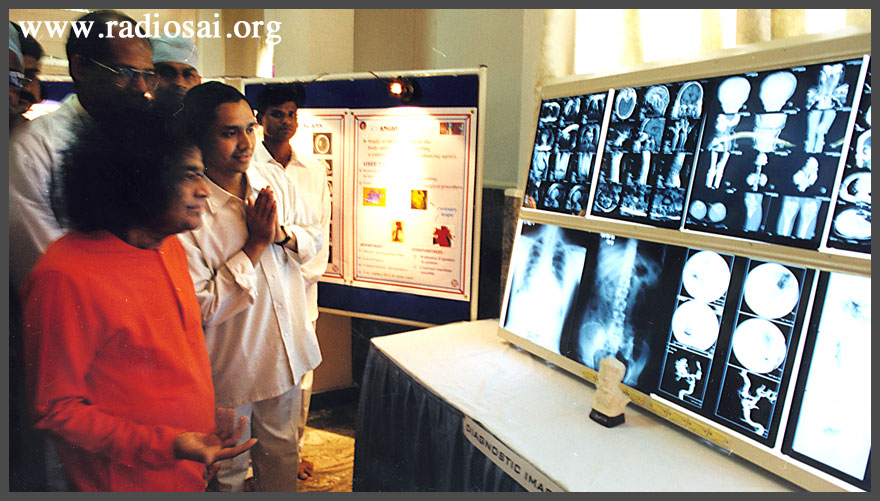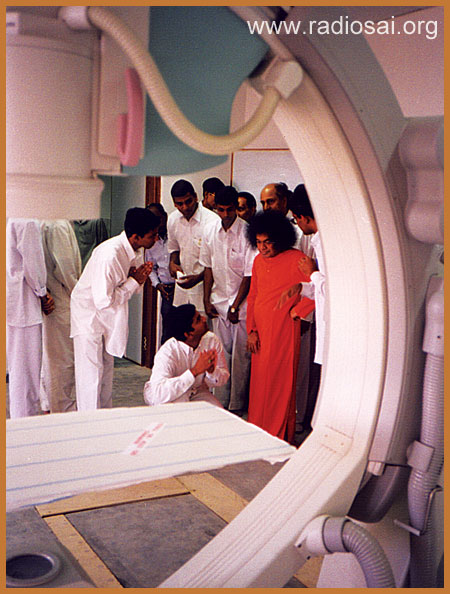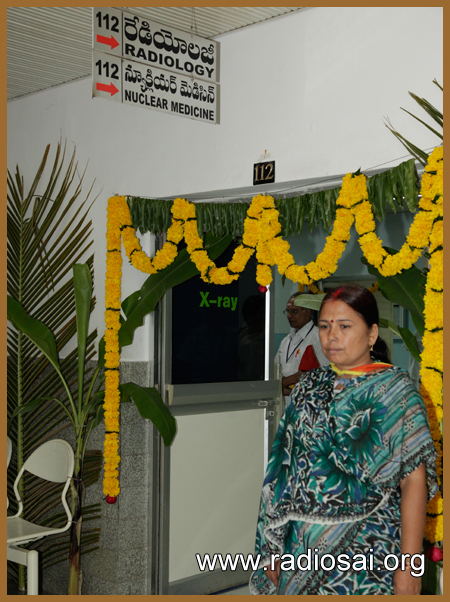|
|
| 'Like' us on Facebook | Follow us: |
Posted on: Nov 11, 2013
Radiology in Baba's Hospitals
Soaring to New Heights for Heightened Patient Care
Mr. S. Ravi Kumar joined Baba's school in Ooty way back in 1978 and once Bhagawan merged this institution with His school in Puttaparthi, he become a student of Sri Sathya Sai Primary School and then of the Sri Sathya Sai Higher Secondary School in Prasanthi Nilayam. He later did his Bachelors in Commerce in the Brindavan Campus of Sri Sathya Sai Institute of Higher Learning followed by Masters in Business Administration in the Prasanthi Nilayam campus. Once he completed this post-graduation, Bhagawan blessed him with the opportunity to work in His Super Speciality Hospital in Puttaparthi which he joined in 1993.
Though he is a committed and commendable healthcare professional at His hospital, Ravi Kumar is more lauded and sought-after for his magical voice. With Bhagawan's direct grace, he has been singing in the Divine Presence right from when he was just 8 years old, and has been blessed with innumerable opportunities of divine interaction and proximity.
This conversation however focusses on the less-known medical side of his personality and the strides that the Department of Radiology in Baba's hospital has made in these two decades; he has been serving as a Manager in this department for 15 years now.
Bishu Prusty (BP): Sairam brother Ravi Kumar! You've been so deeply involved in the health care mission and have been there almost since the inception of the Super Speciality Hospital in Puttaparthi. Can you give us a brief overview of the different roles that Bhagawan blessed you with in the initial years and how it is now?
 |
|
Ravi Kumar (RK): The day I joined in 1993, I was asked to join the IT department in the hospital, which had only one of our elder brothers working there. I had a morbid fear of computers in those days. In fact, I told Him, “Swami, any other department but not computers.”
But Swami said, “Work for a month. If you still find it difficult, you can work elsewhere.” It was probably because I was not so conversant with computers in those days. After that precious one month, as Swami said, I didn't want to leave the IT department.
For five years I worked in that department and in 1998, one of Swami's students who was working in the Radiology department had to leave. Since Radiology is the most expensive department in any hospital and the equipment there is worth crores, Swami said, “Mana pillalu aa department lo unndali - My students should look after this department.”
By then, one of our brothers had joined the IT department and so I was asked to join Radiology.
When Radiology started, we had just one X-ray machine and one ultrasound machine. Three years after the hospital started, we got a CT scanner. Of course, it was the latest in the country at that time in 1995. Even the All India Institute of Medical Sciences, Delhi got a similar CT scanner only after us. That is how progressive this department has been right from then.
All of us students had joined as technical officers, which meant that we did some work as a technician, and also some administrative work, which lent the ‘officer’ part of our designation.
I used to do CT scans and I did it for several years; it was on-the-job training. From those days, we have all grown to become managers in our respective departments.
Then we had only one X-ray machine but now we have two highly capable X-ray machines. All our X-rays are digital now; there are no films anymore. It's a world of difference between what Radiology was then and what it is now. We have a much better CT scanner. In fact, in the next couple of years we are going to have a CT scanner which is probably the best in the world right now. It's a 128-slice CT scanner.
And we are now in the process of installing and commissioning an MRI (Magnetic Resonance Imaging) in the Puttaparthi hospital. Until now we had it only in our sister institution in Whitefield.
 |
|
| Mr. Ravi Kumar at the Department of Radiology in Puttaparthi |
About this MRI, I must tell you that one of the elders who is associated with this project of getting the MRI installed said that a few years ago when he was involved in the construction of one of Swami's projects in Puttaparthi, one day they fell short of a box of nails. They had to ask Swami's permission, go to Anantapur, buy this box of nails and get back for the construction work in Puttaparthi.
He continued, “I have seen those days in Puttaparthi and today when I see a magnet for the MRI coming into the hospital, it brings tears to me.” He said this is what Swami has been giving not just to the people around this area but to everybody around the country.
Let me also add that this is not a simple MRI. It is a 1.5 Tesla 32-channel MRI ― it is top-of-the-line, and this is towards the improvement of patient care. In the last few years since the orthopaedics department started (in 2006), a requirement for MRI came up but it wasn't that severe initially.
Since the MRI was already there in the Whitefield hospital, patients who needed MRI were asked to go there. But now nobody needs to go to Whitefield or Bangalore. They come here and are investigated thoroughly. Now with the latest trends in medicine, not just orthopaedics but even cardiology, urology, and ophthalmology departments – all of them are going to use MRI.
 |
|
| The new 1.5 Tesla 32-channel MRI machine in Baba's Hospital in Puttaparthi; this was inaugurated on October 14, 2013 |
BP: That's heartening to know. What are the other initiatives this department has taken towards delivering better patient care?
RK: We have technologically advanced to such a big level. I must tell you that apart from the fact that we have very good equipment, the big technological advancement we have made is to install a Picture Archiving and Communication System called PACS, whereby all the digital images are captured, stored centrally and distributed not just throughout the hospital but infact throughout the world.
 |
|
Previously when an X-ray or a CT scan was done, you'd take the film and then dispatch it to the doctor; it would take time. It had to be manually sent and at a time when the doctor was available.
But now the instant an X-ray is taken or a scan is done, the images are on the system and the doctor can see it at his workstation that very second. This has sped up the diagnosis and the overall treatment of the patient.
I can't tell you how painful it was in those analogue and paper days. Now we have become paperless and filmless. This has all gone towards patient care. Like I just said, it is not just throughout the hospital. In fact, the doctors sitting in our sister concern in Whitefield can have an instant look at these images, if we need anybody's advice.
We have people from across the world who come and serve in our hospital ― specialists from London, US, Argentina, Australia and various parts of India. They come as volunteer doctors and when we need some specialised help in the diagnosis of a certain case, we give them access to directly log on via a secure access to our PACS server, view the images and give their opinion. This is how it has really helped in better patient care.
Also due to various necessities, we try to accredit the hospital to certain boards and affiliations connected with the Union Health Ministry. This is important to get credibility in the world and also conform to certain quality of health care. But some of us were discussing a few days ago that the biggest accreditation that one should get is that we have followed Swami's teachings and we are accredited by Swami.
Bhagawan came to this hospital in the early years and addressed the staff so lovingly in the central dome and in the beautiful prayer hall. The lessons that He taught in those discourses are for the entire system of health care throughout the world — Swami says that free health care is not cheap health care and He has demonstrated this thoroughly. We have the best and the latest equipment, and we are always getting the best specialists in these fields. Therefore it is not cheap medicine — yes, it is done free of cost but it is very good medicine.
The other part is how one should treat the patient. As one doctor said, “Look into his eyes and talk to him with love.” In His own lovely and humorous way, Swami once said, “When you're feeling the pulse of the patient, don't shake your head very despondently and say ‘No, I don't think you're going to have much longer to live’. This is not the way. Even if the patient is in a bad condition, look at him and speak to him in a positive way. Positivity will get him out of trouble and out of his disease.”
Swami has given so many such snippets and lovely lessons and if we follow them, we are accredited by Swami. This is what distinguishes our hospitals from other commercial establishments.
BP: Every time a patient goes out smiling or a little one comes out of the operation theatre and walks out of the ward after his recovery, jumping with a spring in his/her steps, that is the accreditation we are looking for. It's as if Swami is saying, “Yes, you have done a good job!”
 |
|
| The Department of Radiology in SSSIHMS, Puttaparthi |
Now, if we look at the scenario in India, Radiology is one of the most sought-after departments. Medical students are paying astronomical amounts to get a seat to do their post-graduation in Radiology.
RK: That's true. And that is why we also have post-graduate students in our department. The hospital has academic programs where every department is accredited to run DNB (Diplomate of National Board) courses, run by the National Board of Examinations, Delhi, which comes under the Union Ministry of Health; it is recognized by the Medical Council of India. Our Radiology department in Whitefield along with the Radiology department here at Puttaparthi are allowed to take four students every year.
Radiology is a subject in which it is most difficult to get a pass percentage, but by Swami's blessings, we are at 100 percent pass percentage. This is the ninth year now in Radiology with four students per year. Obviously, we don't collect any fee of any kind ― education has to be free. In fact, the National Board says that there should be no capitation fee but there is something called a tuition fee, a small amount, which a student has to pay to the hospital where he/she is training. But we have waived off even the amount that the National Board says that the candidate should pay.
BP: Top-of-the-line free care to the patient and top-of-the-line learning to aspiring doctors!
RK: Yes. The learning doctors or students are so lucky because we have expert consultants from all over the world giving them training on a daily basis with the use of technology.
BP: Fantastic! It's really so heart-warming that we are part of such a mission which is helping the neediest of this country and this planet. Thank you very much for sharing all this.
RK: Thank you Bishu. It's my pleasure. Sairam.
- Team Radio Sai
What are your impressions about this article? Please share your feedback by writing to h2h@radiosai.org. Do not forget to mention your name and country.






